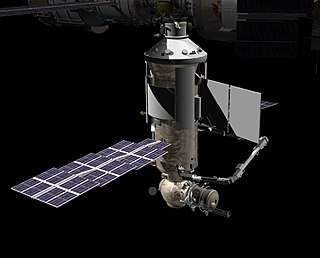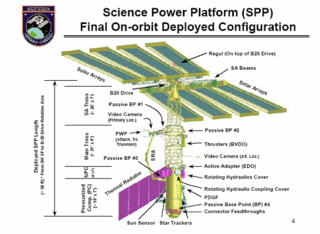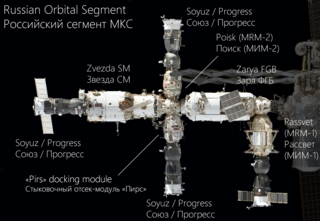
Zvezda, DOS-8, also known as the Zvezda Service Module, is a component of the International Space Station (ISS). It was the third module launched to the station, and provides all of the station's life support systems, some of which are supplemented in the USOS, as well as living quarters for two crew members. It is the structural and functional center of the Russian portion of the station - the Russian Orbital Segment.
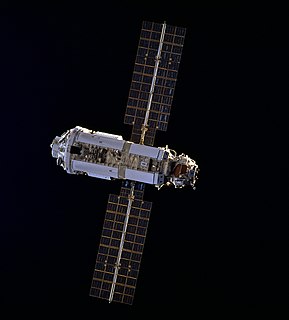
Zarya, also known as the Functional Cargo Block or FGB, is the first module of the International Space Station to be launched. The FGB provided electrical power, storage, propulsion, and guidance to the ISS during the initial stage of assembly. With the launch and assembly in orbit of other modules with more specialized functionality, Zarya is now primarily used for storage, both inside the pressurized section and in the externally mounted fuel tanks. The Zarya is a descendant of the TKS spacecraft designed for the Russian Salyut program. The name Zarya, which means sunrise, was given to the FGB because it signified the dawn of a new era of international cooperation in space. Although it was built by a Russian company, it is owned by the United States.
The Russian Research Module (RM) was to be a Russian component of the International Space Station (ISS) that provided facilities for Russian science experiments and research.

Pirs – also called "Stykovochny Otsek 1" ("SO-1") (Russian: Стыковочный отсек, "docking module" and DC-1 – is a Russian module on the International Space Station. Pirs was launched in August 2001. It provides the ISS with one docking port for Soyuz and Progress spacecraft, and allows egress and ingress for spacewalks by cosmonauts using Russian Orlan space suits.

Rassvet, also known as the Mini-Research Module 1 (MRM-1) and formerly known as the Docking Cargo Module (DCM), is a component of the International Space Station (ISS). The module's design is similar to the Mir Docking Module launched on STS-74 in 1995. Rassvet is primarily used for cargo storage and as a docking port for visiting spacecraft. It was flown to the ISS aboard Space ShuttleAtlantis on the STS-132 mission on May 14, 2010, and was connected to the ISS on May 18. The hatch connecting Rassvet with the ISS was first opened on May 20. On 28 June 2010, the Soyuz TMA-19 spacecraft performed the first docking with the module.

The process of assembling the International Space Station (ISS) has been under way since the 1990s. Zarya, the first ISS module, was launched by a Proton rocket on November 20, 1998. The STS-88 shuttle mission followed two weeks after Zarya was launched, bringing Unity, the first of three node modules, and connecting it to Zarya. This bare 2-module core of the ISS remained unmanned for the next one and a half years, until in July 2000 the Russian module Zvezda was launched by a Proton rocket, allowing a maximum crew of two astronauts or cosmonauts to be on the ISS permanently.

Soyuz TMA-17 was a human spaceflight mission to the International Space Station (ISS). TMA-17 crew members participated in ISS Expedition 22 and Expedition 23. The mission ended when the Soyuz TMA-17 capsule landed on June 2, 2010.

Poisk, also known as the Mini-Research Module 2, Малый исследовательский модуль 2, or МИМ 2, is a docking module of the International Space Station. Its original name was Docking Module 2, as it is almost identical to the Pirs Docking Compartment. Added in 2009, Poisk was the first major Russian addition to the International Space Station since 2001. Poisk is overall the same design as a docking module Pirs. Whereas Pirs has been attached to the nadir ("bottom") port of Zvezda module, Poisk is attached to the zenith ("top"); Pirs is closer to the Earth with the ISS in its usual orientation, and Poisk is on the other side. Poisk is Russian for explore or search. Poisk combines various docking, EVA, and science capabilities. It has two egress hatches for EVA's in addition to the two spacecraft docking ports. Although Poisk is designated as Mini-Research Module 2, it arrived before Mini-Research Module 1 (Rassvet), which had a different design; Poisk looks more like the Pirs docking port, which is not designated as a mini-research module.

The Functional Cargo Block or FGB was part of the Soviet TKS spacecraft. The TKS spacecraft was intended to be used as a resupply craft for Almaz space stations and saw some test flights in the Salyut space station program. The TKS spacecraft was formed by mating a FGB with a VA spacecraft, with both the VA and the FGB being capable of independent operation.

The Orbital Piloted Assembly and Experiment Complex was a 2009–2017 Russian proposed third-generation modular space station for Low Earth orbit.

Progress M-09M, identified by NASA as Progress 41 or 41P, is a Progress spacecraft which was launched in 2011 to resupply the International Space Station. It was the ninth Progress-M 11F615A60 spacecraft to be launched, and has the serial number 409. The spacecraft was manufactured by RKK Energia, and is operated by the Russian Federal Space Agency. It arrived at the space station during Expedition 26, and undocked during Expedition 27.

Progress M-10M, identified by NASA as Progress 42 or 42P, is a Progress spacecraft which was launched on 27 April 2011 to resupply the International Space Station. It was the tenth Progress-M 11F615A60 spacecraft to be launched, and has the serial number 410. The spacecraft was manufactured by RKK Energia, and is operated by the Russian Federal Space Agency. On 29 April 2011 it arrived at the space station's Pirs Docking Compartment during Expedition 27.
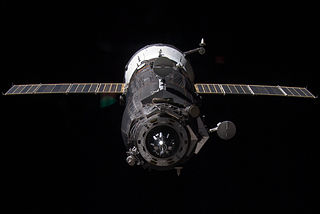
Progress M-13M, identified by NASA as Progress 45 or 45P, is a Progress spacecraft which reached the International Space Station (ISS) on 2 November 2011. The Progress M-13M spacecraft lifted off from the Baikonur Cosmodrome in Kazakhstan at 10:11 GMT on 30 October, starting off the 45th unmanned Russian space station resupply mission. The spacecraft was manufactured by RKK Energia, and is operated by the Russian Federal Space Agency. The Soyuz-U rocket carrying the cargo ship functioned nominally as advertised. Approximately nine minutes into the launch, Progress M-13M reached its planned preliminary orbit.
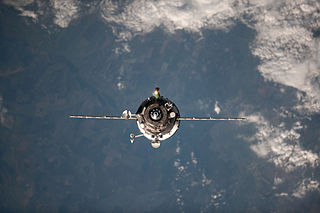
Progress M-15M, identified by NASA as Progress 47 or 47P, is a Progress spacecraft used by Roskosmos to resupply the International Space Station during 2012. The fifteenth Progress-M 11F615A60 spacecraft, it has the serial number 414 and was built by RKK Energia. It arrived at the ISS in late April to deliver supplies to the Expedition 30 crew, and departed the ISS in late July.
Science-Power Module-1 is a module scheduled to arrive at the international space station in 2022. It is going to dock to the Uzlovoy Module, which is scheduled to be attached to the Nauka Module. If Nauka is canceled, then both the Uzlovoy module and NEM-1 would dock at the zenith port of Zvezda. SPM-1 is also a required component for the OPSEK space station. The module is a new generation module which can replace the Zarya Functional Cargo Block (FGB) originally used in the TKS spacecraft which was the basis for the Zarya FGB module.
Soyuz MS-14 is a Soyuz spaceflight to the International Space Station planned for August 2019. It will carry no crew members, as it is intended to test a modification of the launch abort system for integration with the Soyuz-2.1a launch vehicle. Unlike the traditional Soyuz-FG launcher which is turned on its launchpad to set azimuth of its flight, Soyuz-2 performs a roll maneuver during its flight to change direction. The maneuver may trigger the analog launch abort system designed for Soyuz-FG. Soyuz MS-14 will test a solution for this issue. The 14th flight of Soyuz MS will be the 143rd flight of a Soyuz spacecraft. If all goes well, future crewed missions will use the new configuration starting with Soyuz MS-16 in early 2020.





